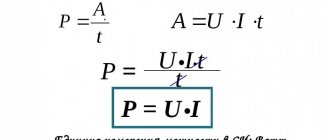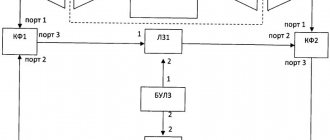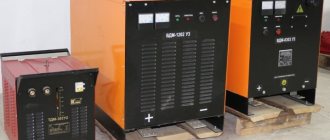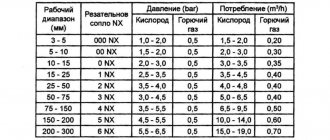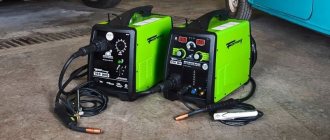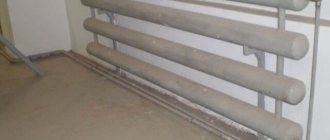To select the cross-section of power cables and wires when laying electrical networks for consumers, you need to know what power devices will be included in them. You can learn how to calculate the power consumption of an electrical appliance by understanding the very concept of power. For this, information from the school curriculum and basic concepts about current, voltage, and resistance will be enough. In addition, this knowledge is needed when purchasing household electrical appliances.
Electric current power
Total power and its components
Electrical power is a quantity responsible for the rate of change or transmission of electricity. The total power is denoted by the letter S and is found as the product of the effective values of current and voltage. Its unit of measurement is volt-ampere (VA; V A).
Total power can consist of two components: active (P) and reactive (Q).
Active power is measured in watts (W; W), reactive power is measured in vars (Var).
It depends on what type of load is included in the electricity consumption circuit.
Active load
This type of load is an element that resists electric current. As a result, the current does the work of heating the load, and the electricity is converted into heat. If a resistor of any resistance is connected in series to a battery, then the current passing through the closed circuit will heat it until the battery is discharged.
Attention! An example of a thermal electric heater (TEH) can be given as an active load in AC networks. The heat generated on it is the result of the work of electricity.
Similar consumers also include spirals of light bulbs, electric stoves, ovens, irons, and boilers.
Capacitive load
Such loads are devices that can accumulate energy in electric fields and create movement (oscillation) of power from source to load and back. Capacitors, cable lines (capacitance between conductors), capacitors and inductors connected in series and parallel in a circuit serve as capacitive loads. Sound power amplifiers and synchronous electric motors in overexcited mode also load the lines with a capacitive component.
Inductive load
When the consumer of electricity is certain equipment, which includes:
- transformers;
- three-phase asynchronous motors, pumps.
On the plates attached to the equipment you can see such a characteristic as cos ϕ. This is the phase shift coefficient between current and voltage in the alternating current network into which the equipment will be connected. It is also called the power factor; the closer cos ϕ to unity, the better.
Important! When a device contains inductive or capacitive components: transformers, chokes, windings, capacitors, the sinusoidal current lags in phase with the voltage by a certain angle. Ideally, the capacitance provides a phase shift of -900, and the inductance provides a phase shift of +900.
Cos ϕ values depending on the type of load
The capacitive and inductive components together form reactive power. Then the total power formula looks like:
S = √ (P2 + Q2),
Where:
- S – apparent power (VA);
- P – active part (W);
- Q – reactive part (Var).
If we display this graphically, then we can see that the vector addition of P and Q will be the total value of S - the hypotenuse of the power triangle.
Graphic explanation of the meaning of total power
What is it measured in?
The unit of measurement of electrical power is W for Russia. By international standards - W. This is the energy provided per unit of time. One W is equal to a joule per second (J/s). Moreover, a joule is a unit of electrical power, a second is a unit of time.
For small values, multiple prefixes are used: “milli-”, “micro-”, for large values - “mega-”. For example: 5,800 W = 5.8 kilowatts = 5.8 kW.
When you multiply 1 Kilowatt by 1 hour, you get a Kilowatt-hour (kW x h). This is a unit of measurement of the amount of electricity provided to subscribers. It is used by energy enterprises that own the appropriate equipment (generators and transformer substations). They generate and convert the produced electricity, which is then distributed to consumers.
In the same way, the energy capacity of batteries is measured in units of ampere hours (Ah). Portable types of energy storage batteries are measured in milliampere hours (mAh).
The energy in batteries is measured in milliamp hours (mAh). Source listtopa.ru
For the unit of measurement Watt, according to international standards, the letter designation W is allocated after James Watt. He was the first to use the term “horsepower,” which today is an obsolete unit of the W parameter.
Energy conversion indicators:
- horsepower (HP) - 746 W;
- kilo Watts (kW) – 1×1000 W;
- megawatts (MW) −1×1000000 W;
- gigawatt (GW) – 1×1000000000 W.
Today, "horsepower" is used to indicate the second measure of engine power in vehicles.
Negative effects of reactive load
Learn to easily calculate the power consumption of an electrical appliance
The reactive load does not perform any useful work. Fluctuations in the reactive component from source to consumer only cause parasitic losses. In addition, industrial enterprises are required to pay for the reactive energy supplied to them. This is due to the fact that most energy receivers are electric motors and transformers. The amount of electricity consumed (kWh) does not all go to useful work, but you also need to pay for its reactive component.
Capacitor compensation units will help solve this problem. After all, if you connect a capacitive load in parallel with an inductive load, you can reduce the effect of parasitic currents to a minimum. Such installations are installed at substations supplying consumers.
Why Circuit Reactance Affects AC Power
A sinusoidal voltage harmonic, entering a resistive resistance, changes the magnitude of the current without its deviation on the complex plane.
Such current performs useful work with minimal energy losses, generating active power. The frequency of the signal does not have any effect on it.
The resistance of the capacitor and inductance depends on the frequency of the harmonic. Its opposition deflects the direction of the current on each of these elements in different directions.
Such processes are associated with the loss of part of the energy for useless transformations. They consume power Q, which is called reactive. Its influence on the total power S and the connection with active P is conveniently represented graphically by a right triangle.
I wanted to draw it against the background of equipment made from piles of porcelain and metal, where I had to work for quite a long time. Got distracted. Don't judge harshly for this.
Compare it with the resistance triangle I published earlier. Do you find any common features?
They are the geometric proportions of the figure, the formulas describing them and the angle φ, which determines the total power loss. Let me move on to a more detailed consideration of them.
Formula for calculations
How to calculate electrical energy consumption
All data necessary to be substituted into the formula for calculations can either be measured or taken from the characteristics of the instruments used.
For your information. If the passport data indicates the value of cos ϕ, it means that the electricity received by the device will have a reactive component. This also needs to be taken into account when calculating.
The formula for calculation is:
P = I * U * cos ϕ,
Where:
- I – current in amperes;
- U – voltage in volts;
- cos ϕ – phase shift.
In the case of an active load, the phase shift is not substituted into the formula, and it has the form:
P = I * U.
Features of calculation
To calculate power without having complete data on current and voltage consumption, you can use average characteristics. By consulting reference books, you can find out that lighting equipment can consume current up to 15 A. The maximum current of powerful devices reaches 50-60 A. The power factor, if it is not indicated or known, can be taken as 0.7 - this is the average value.
Single-phase voltage in a household network is 220 V. Its linear value in three-phase networks is 380 V.
Cosine phi for various consumers - table
| Name of electrical appliance | cos φ |
| Boiler | 1 |
| Bulgarian | 0.8 |
| Vacuum pump | 0.85 |
| Induction furnaces | 0.85 |
| Compressor | 0.7 |
| Computer | 0.95 |
| Coffee maker | 1 |
| Gas discharge lamps | 0.4-0.6 |
| Fluorescent lamps | 0.95 |
| Incandescent lamps | 1 |
| Heater | 1 |
| Hammer | 0.85 |
| Vacuum cleaner | 0.9 |
| Microwave | 1 |
| Washing machine | 0.9 |
| TV | 1 |
| Iron | 1 |
| Hairdryer | 1 |
| Fridge | 0.95 |
| Electric drill | 0.85 |
| Electric motors | 0.7-0.8 |
| Electric stove | 1 |
| Electric arc welding | 0.3-0.6 |
| Electric kettle | 1 |
Mathematical operations
The basic formula allows you to calculate an unknown quantity when the other two are known. For example, if the current consumed by the device is known I = 2 A and the network voltage U = 220 V, then the power consumption is equal to P = 2 * 220 = 440 W.
For example, it is known that the iron consumes 2 kW, and the voltage in the outlet is 220 V, then you can find the current strength for which the cross-section of the power cord is designed.
I = P/U = 2000/220 = 9.1 A.
In the case of fractional values, when using a calculator for calculations, the obtained values are rounded to tenths of the units of the desired value.
Basic formulas for calculation
Selection of circuit breaker rating
Current source efficiency
To solve practical problems when connecting several consumers to a standard 220 V home network, the total current strength in individual lines is calculated.
Calculation procedure for one household air conditioner:
- power consumption – 1,250 W;
- cosϕ – 0.75;
- I = 1,250/ (220 * 0.75) = 7.58 A.
Other consumers make calculations in a similar way. Less powerful devices are combined into a unit for connection to one line. Make the necessary adjustments taking into account placement in order to economically use cable products. A suitable machine is selected from the standard model range in the higher side of the nominal value (with a reserve of current strength).
Next, check the compliance of the conductors. The cross-sectional area is calculated using the well-known geometric formula:
S = ¼ * π * d2.
Next, according to the table from the PUE, select the appropriate option. For the example presented above, when connecting only one air conditioner, it is enough to use a copper conductor with a cross-sectional area of 1.5 mm square. This is enough for long-term transmission of current up to 19 A.
Rules for calculating power consumption
In everyday life, when the need arises to independently determine the power consumption of electricity, do the following:
- determine the voltage required to power the device;
- find out the rated current from the passport data.
How to find out the power of an electrical appliance if not a single parameter is known? Household electrical appliances are designed for 220 V.
To determine power, it is permissible to measure current consumption. This can be done using an ammeter. It is connected to the circuit in series, having previously set the highest measurement limit - at least a hundred amperes. Current clamp meters will help you easily measure current, for which one of the conductors is grasped by the clamp sensor, and the readings are displayed on the display. Knowing the voltage, multiply it by the measured current to obtain the amount of power consumed.
Clamp meter
How much electricity does a kettle consume?
An electric kettle is a convenient household appliance that can provide its owners with boiling water in a matter of minutes.
It is necessary to calculate how many kilowatts a kettle consumes, taking into account the power of the device and the maximum volume of liquid that it can bring to a boil. The larger the displacement of the device, the more time it will take to heat the water, and accordingly the amount of electricity consumed increases. On the other hand, the high power of the kettle contributes to its fast operation. However, it requires a sufficient amount of electricity.
All electric kettles are different in their parameters and, accordingly, in their level of energy consumption.
To calculate how much a kettle consumes, you should perform the following calculations:
- The power of the device is taken from the passport;
- the time it takes to boil water in the kettle is calculated;
- electricity consumption per unit time is determined;
- the resulting value should be multiplied by the number of times the water is boiled;
- monthly electricity consumption is determined.
Based on the table, the power of the electrical appliance is in the range of 700-3000 W, which depends on the volume of the bowl, body material, displacement, type of heating element, and chemical composition of the water. The heating element can be open (spiral) or closed (plate) type. The first option provides a high rate of water heating and, accordingly, uses less energy.
The energy consumption of the device is also influenced by the housing material. In a metal bowl, water heats up faster. However, an additional amount of electricity is spent on heating the case. Glass also heats up quickly, but retains heat less well. Ceramic has a slow heating rate, but the water in the kettle will remain hot for a long time.
Note! Boiling water in an electric kettle is less expensive than using an electric stove.
If you pour a minimum amount of water into the kettle without reserve, you can reduce the waste of both water and electricity.
To reduce the kettle's energy consumption, unplug the appliance from the outlet when not in use. The required volume of water should be poured into it, without reserve. You should monitor the condition of the heating element by regularly descaling it.
Calculation of light bulb power
The selection of incandescent lamp power depends on the desired level of illumination of the living space. One 100 W light bulb, working in the dark for at least 12 hours, consumes 1.2 kW of power. For a month this will be 36 kW, for a year - at least 432 kW. If there are 10 light bulbs in an apartment, then the total annual consumption will be 4320 kW. If the price for 1 kW of electricity is 5 rubles, the amount turns out to be decent – 21,000 rubles. Therefore, replacing incandescent lamps with energy-saving light sources: LED lamps, LED strips and the like allows you to save money. In addition, reducing the power of such light bulbs does not reduce the luminous flux. The reduced supply voltage of LED strips also reduces the amount of power consumed.
Power measurement devices
To measure P, you can use special instruments. A multimeter is suitable for this, to which you can connect a current clamp. How to measure power with a multimeter? The tester is switched on to the alternating voltage measurement mode; the clamps should grasp only one conductor connected to the load.
Measuring with a multimeter
Separating conductors in a cable is not always convenient. In addition, after measurements you need to calculate the power using the formula.
Power meter
To measure, you can use a special device - a wattmeter. The device is plugged into a power outlet, and the load whose power needs to be measured is connected to its output socket. The results of the measurement are displayed on the display in kilowatts.
Power meter
Measuring power with an electric meter
Using a residential electricity meter, you can also check the power consumption of an individual device. To do this you need:
- turn off all energy consumers, leaving only the device under test in consumption mode;
- note the readings at the current moment and record their values in an hour;
- subtract the latest values from previous readings;
- the result will be a measured value.
The main disadvantage of this block of actions is the shutdown of other necessary household appliances.
Information. When using this method, taking a moment, you can see if there is a hidden current leak and the serviceability of the meter. When all devices are turned off, the electric meter should stop.
Energy consumption
Calculating energy consumption for a house or apartment is not particularly difficult. To do this, you need to perform the following algorithm of actions:
- make a table of all electrical appliances used in the house, including lighting lamps;
- put in separate columns: device power, operating hours per day;
- for each energy consumer, calculate (by multiplying the power by the operating time) the average daily consumption;
- sum up all the obtained power values.
Such a calculation will give a real picture of electricity consumption. Using this data, you can control consumption and adjust the daily power consumption of each device.
It does not matter how power consumption is calculated or measured. The main task of the process is to correctly select the cross-section of conductors for wiring, supplying power cables and ensure that automatic protection is triggered. The cable supplying voltage to the room must withstand the simultaneous switching on of all consumers located in it for a long time. Its choice directly depends on the accuracy of determining the power of consumers.
Additional recommendations
Quite a lot of things in our lives depend on power. Therefore, we want to give you some tips to help protect and decorate it.
To reduce costs, it is necessary to optimize them. For example, when you leave a room, you can turn off the lights in it. This will reduce energy consumption, and at the end of the month you will receive bills with more pleasant numbers. Besides turning off the lights, there are many other ways to reduce the amount of energy you use.
You can use electrical appliances that consume less power. For example, the cleanliness in your apartment will not become worse if you use a medium-power vacuum cleaner. This also applies to other household appliances. The main thing is that your quality of life does not deteriorate. And this can be done using medium-power devices. After all, they do everything necessary and do not consume much energy.
If you still don’t understand all the details of calculating power, don’t torture yourself. It’s better to use an online calculator or install special applications on your smartphone to calculate it. Remember, in life it is important to save not only energy, but also time.
Electric power calculations are carried out by engineers who develop household appliances. They do this to avoid short circuits and fires. Remember, this is primarily for your safety.
Now you know how to calculate power, and what is the essence of this physical quantity. When choosing a household appliance, you will have an idea of how much power you need to achieve a particular goal. I wish you success!
Video
Coffee capsule Nescafe Dolce Gusto Cappuccino, 3 packs of 16 capsules
1305 ₽ More details
Coffee capsules Nescafe Dolce Gusto Cappuccino, 8 servings (16 capsules)
435 ₽ More details
Bluetooth adapters


